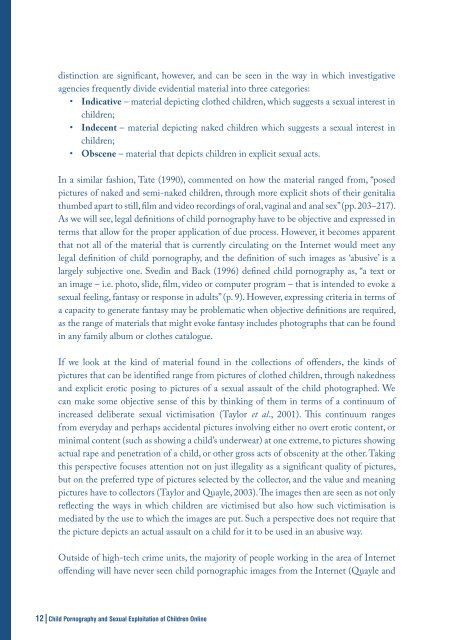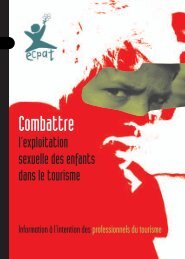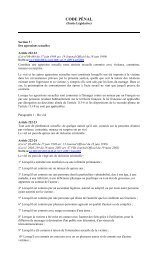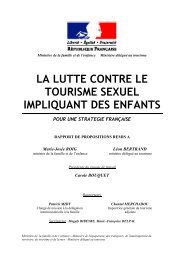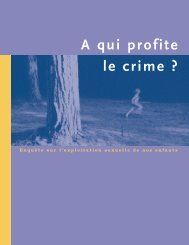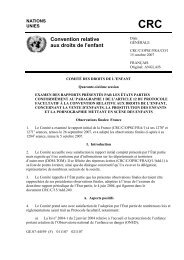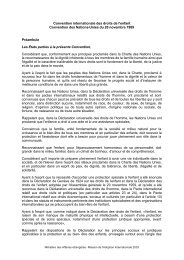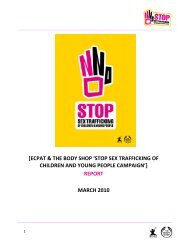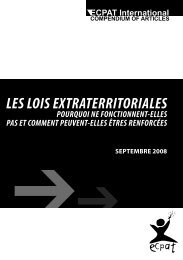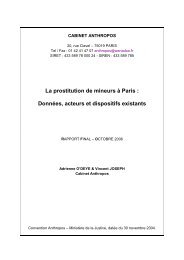child pornography and sexual exploitation of children online
child pornography and sexual exploitation of children online
child pornography and sexual exploitation of children online
Create successful ePaper yourself
Turn your PDF publications into a flip-book with our unique Google optimized e-Paper software.
distinction are significant, however, <strong>and</strong> can be seen in the way in which investigative<br />
agencies frequently divide evidential material into three categories:<br />
• Indicative – material depicting clothed <strong>child</strong>ren, which suggests a <strong>sexual</strong> interest in<br />
<strong>child</strong>ren;<br />
• Indecent – material depicting naked <strong>child</strong>ren which suggests a <strong>sexual</strong> interest in<br />
<strong>child</strong>ren;<br />
• Obscene – material that depicts <strong>child</strong>ren in explicit <strong>sexual</strong> acts.<br />
In a similar fashion, Tate (1990), commented on how the material ranged from, “posed<br />
pictures <strong>of</strong> naked <strong>and</strong> semi-naked <strong>child</strong>ren, through more explicit shots <strong>of</strong> their genitalia<br />
thumbed apart to still, film <strong>and</strong> video recordings <strong>of</strong> oral, vaginal <strong>and</strong> anal sex” (pp. 203–217).<br />
As we will see, legal definitions <strong>of</strong> <strong>child</strong> <strong>pornography</strong> have to be objective <strong>and</strong> expressed in<br />
terms that allow for the proper application <strong>of</strong> due process. However, it becomes apparent<br />
that not all <strong>of</strong> the material that is currently circulating on the Internet would meet any<br />
legal definition <strong>of</strong> <strong>child</strong> <strong>pornography</strong>, <strong>and</strong> the definition <strong>of</strong> such images as ‘abusive’ is a<br />
largely subjective one. Svedin <strong>and</strong> Back (1996) defined <strong>child</strong> <strong>pornography</strong> as, “a text or<br />
an image – i.e. photo, slide, film, video or computer program – that is intended to evoke a<br />
<strong>sexual</strong> feeling, fantasy or response in adults” (p. 9). However, expressing criteria in terms <strong>of</strong><br />
a capacity to generate fantasy may be problematic when objective definitions are required,<br />
as the range <strong>of</strong> materials that might evoke fantasy includes photographs that can be found<br />
in any family album or clothes catalogue.<br />
If we look at the kind <strong>of</strong> material found in the collections <strong>of</strong> <strong>of</strong>fenders, the kinds <strong>of</strong><br />
pictures that can be identified range from pictures <strong>of</strong> clothed <strong>child</strong>ren, through nakedness<br />
<strong>and</strong> explicit erotic posing to pictures <strong>of</strong> a <strong>sexual</strong> assault <strong>of</strong> the <strong>child</strong> photographed. We<br />
can make some objective sense <strong>of</strong> this by thinking <strong>of</strong> them in terms <strong>of</strong> a continuum <strong>of</strong><br />
increased deliberate <strong>sexual</strong> victimisation (Taylor et al., 2001). This continuum ranges<br />
from everyday <strong>and</strong> perhaps accidental pictures involving either no overt erotic content, or<br />
minimal content (such as showing a <strong>child</strong>’s underwear) at one extreme, to pictures showing<br />
actual rape <strong>and</strong> penetration <strong>of</strong> a <strong>child</strong>, or other gross acts <strong>of</strong> obscenity at the other. Taking<br />
this perspective focuses attention not on just illegality as a significant quality <strong>of</strong> pictures,<br />
but on the preferred type <strong>of</strong> pictures selected by the collector, <strong>and</strong> the value <strong>and</strong> meaning<br />
pictures have to collectors (Taylor <strong>and</strong> Quayle, 2003). The images then are seen as not only<br />
reflecting the ways in which <strong>child</strong>ren are victimised but also how such victimisation is<br />
mediated by the use to which the images are put. Such a perspective does not require that<br />
the picture depicts an actual assault on a <strong>child</strong> for it to be used in an abusive way.<br />
Outside <strong>of</strong> high-tech crime units, the majority <strong>of</strong> people working in the area <strong>of</strong> Internet<br />
<strong>of</strong>fending will have never seen <strong>child</strong> pornographic images from the Internet (Quayle <strong>and</strong><br />
12|Child Pornography <strong>and</strong> Sexual Exploitation <strong>of</strong> Children Online


